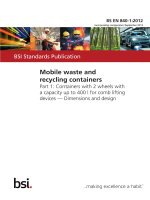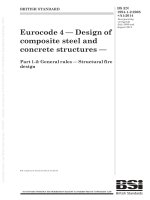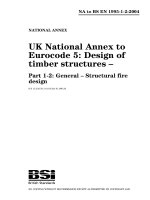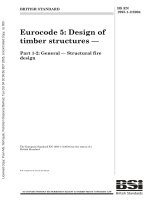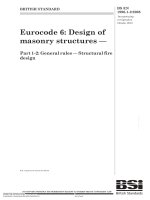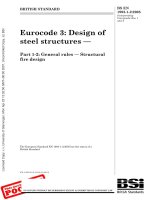Bsi bs en 61482 1 2 2014
Bạn đang xem bản rút gọn của tài liệu. Xem và tải ngay bản đầy đủ của tài liệu tại đây (1.43 MB, 34 trang )
BS EN 61482-1-2:2014
BSI Standards Publication
Live working — Protective
clothing against the thermal
hazards of an electric arc
Part 1-2: Test methods — Method 2:
Determination of arc protection class
of material and clothing by using a
constrained and directed arc (box test)
BRITISH STANDARD
BS EN 61482-1-2:2014
National foreword
This British Standard is the UK implementation of EN 61482-1-2:2014. It is
identical to IEC 61482-1-2:2014. It supersedes BS EN 61482-1-2:2007, which
will be withdrawn on 13 November 2017.
The UK participation in its preparation was entrusted to Technical
Committee PEL/78, Tools for live working.
A list of organizations represented on this committee can be obtained on
request to its secretary.
This publication does not purport to include all the necessary provisions of
a contract. Users are responsible for its correct application.
© The British Standards Institution 2015
Published by BSI Standards Limited 2015.
ISBN 978 0 580 79850 4
ICS 13.220.40; 29.260; 29.260.99
Compliance with a British Standard cannot confer immunity from
legal obligations.
This British Standard was published under the authority of the
Standards Policy and Strategy Committee on 31 January 2015.
Amendments/corrigenda issued since publication
Date
Text affected
EN 61482-1-2
EUROPEAN STANDARD
NORME EUROPÉENNE
EUROPÄISCHE NORM
December 2014
ICS 13.220.40; 29.260; 29.260.99
Supersedes EN 61482-1-2:2007
English Version
Live working - Protective clothing against the thermal hazards of
an electric arc - Part 1-2: Test methods - Method 2:
Determination of arc protection class of material and clothing by
using a constrained and directed arc (box test)
(IEC 61482-1-2:2014)
Travaux sous tension - Vêtements de protection contre les
dangers thermiques d'un arc électrique - Partie 1-2: Méthodes
d'essai - Méthode 2: Détermination de la classe de protection
contre l'arc de matériaux et de vêtements au moyen d'un arc
dirigé et contraint (enceinte d'essai)
(CEI 61482-1-2:2014)
Arbeiten unter Spannung - Schutzkleidung gegen die
thermischen Gefahren eines elektrischen Lichtbogens Teil 1-2: Prüfverfahren - Verfahren 2: Bestimmung der
Lichtbogen-Schutzklasse des Materials und der Kleidung unter
Verwendung eines gerichteten Prüflichtbogens (Box-Test)
(IEC 61482-1-2:2014)
This European Standard was approved by CENELEC on 2014-11-13. CENELEC members are bound to comply with the CEN/CENELEC
Internal Regulations which stipulate the conditions for giving this European Standard the status of a national standard without any alteration.
Up-to-date lists and bibliographical references concerning such national standards may be obtained on application to the CEN-CENELEC
Management Centre or to any CENELEC member.
This European Standard exists in three official versions (English, French, German). A version in any other language made by translation
under the responsibility of a CENELEC member into its own language and notified to the CEN-CENELEC Management Centre has the
same status as the official versions.
CENELEC members are the national electrotechnical committees of Austria, Belgium, Bulgaria, Croatia, Cyprus, the Czech Republic,
Denmark, Estonia, Finland, Former Yugoslav Republic of Macedonia, France, Germany, Greece, Hungary, Iceland, Ireland, Italy, Latvia,
Lithuania, Luxembourg, Malta, the Netherlands, Norway, Poland, Portugal, Romania, Slovakia, Slovenia, Spain, Sweden, Switzerland,
Turkey and the United Kingdom.
European Committee for Electrotechnical Standardization
Comité Européen de Normalisation Electrotechnique
Europäisches Komitee für Elektrotechnische Normung
CEN-CENELEC Management Centre: Avenue Marnix 17, B-1000 Brussels
© 2014 CENELEC All rights of exploitation in any form and by any means reserved worldwide for CENELEC Members.
Ref. No. EN 61482-1-2:2014 E
BS EN 61482-1-2:2014
EN 61482-1-2:2014
-2-
Foreword
The text of document 78/1053/FDIS, future edition 2 of IEC 61482-1-2, prepared by IEC/TC 78 "Live
working" was submitted to the IEC-CENELEC parallel vote and approved by CENELEC as
EN 61482-1-2:2014.
The following dates are fixed:
•
latest date by which the document has to be implemented at
national level by publication of an identical national
standard or by endorsement
(dop)
2015-08-13
•
latest date by which the national standards conflicting with
the document have to be withdrawn
(dow)
2017-11-13
This document supersedes EN 61482-1-2:2007.
Attention is drawn to the possibility that some of the elements of this document may be the subject of
patent rights. CENELEC [and/or CEN] shall not be held responsible for identifying any or all such
patent rights.
Endorsement notice
The text of the International Standard IEC 61482-1-2:2014 was approved by CENELEC as a
European Standard without any modification.
In the official version, for Bibliography, the following notes have to be added for the standards indicated:
IEC 61482-1-1
NOTE
Harmonized as EN 61482-1-1.
ISO 3175-2
NOTE
Harmonized as EN ISO 3175-2.
ISO 6330
NOTE
Harmonized as EN ISO 6330.
ISO 13688:2013
NOTE
Harmonized as EN ISO 13688:2013 (not modified).
ISO 15797
NOTE
Harmonized as EN ISO 15797.
BS EN 61482-1-2:2014
EN 61482-1-2:2014
-3-
Annex ZA
(normative)
Normative references to international publications
with their corresponding European publications
The following documents, in whole or in part, are normatively referenced in this document and are
indispensable for its application. For dated references, only the edition cited applies. For undated
references, the latest edition of the referenced document (including any amendments) applies.
NOTE 1
When an International Publication has been modified by common modifications, indicated by (mod),
the relevant EN/HD applies.
NOTE 2
Up-to-date information on the latest versions of the European Standards listed in this annex is
available here: www.cenelec.eu.
Publication
Year
Title
EN/HD
Year
ISO 9151
1995
Protective clothing against heat and flame Determination of heat transmission on
exposure to flame
-
-
–2–
BS EN 61482-1-2:2014
IEC 61482-1-2:2014 © IEC 2014
CONTENTS
1
Scope .............................................................................................................................. 6
2
Normative references ...................................................................................................... 6
3
Terms, definitions and symbols........................................................................................ 6
3.1
Terms and definitions .............................................................................................. 6
3.2
Symbols and units used in this document .............................................................. 11
4
Principle of the test method ........................................................................................... 11
4.1
Material box test procedure ................................................................................... 11
4.2
Garment box test procedure .................................................................................. 11
5
Significance and use of the test method ........................................................................ 12
6
Test apparatus .............................................................................................................. 12
6.1
Test apparatus and test box .................................................................................. 12
6.2
Material box test procedure ................................................................................... 15
6.2.1
Arrangement of the material box test procedure ............................................. 15
6.2.2
Test plate (panel) construction ....................................................................... 16
6.2.3
Sensor construction ....................................................................................... 17
6.2.4
Sensor response ........................................................................................... 17
6.3
Garment box test procedure .................................................................................. 17
6.3.1
Arrangement of the garment box test procedure ............................................ 17
6.3.2
Mannequin construction ................................................................................. 17
6.4
Electric supply and electrodes .............................................................................. 18
6.4.1
Test circuit ..................................................................................................... 18
6.4.2
Test circuit control ......................................................................................... 18
6.4.3
Electrodes ..................................................................................................... 18
6.4.4
Fuse wire ....................................................................................................... 18
6.5
Electric test arc characteristics ............................................................................. 19
6.6
Measurement and data acquisition system ............................................................ 19
7
Operator safety .............................................................................................................. 19
8
Specimen preparation .................................................................................................... 20
8.1
Description of the test specimens ......................................................................... 20
8.1.1
Test specimens for material box test procedure ............................................. 20
8.1.2
Test specimens for garment box test procedure ............................................. 20
8.2
Pre-treatment by cleaning ..................................................................................... 20
8.3
Pre-conditioning of the test specimens .................................................................. 20
9
Calibration ..................................................................................................................... 20
9.1
Data acquisition system pre-calibration ................................................................. 20
9.2
Calorimeter calibration check ................................................................................ 20
9.3
Arc exposure calibration ....................................................................................... 21
9.4
Calibration of the electric test circuit and testing ................................................... 21
9.5
Confirmation of test apparatus setting ................................................................... 22
9.6
Preparing and conditioning of the box ................................................................... 22
10 Apparatus care and maintenance .................................................................................. 22
10.1
10.2
10.3
Surface reconditioning of the sensors ................................................................... 22
Care of test plate and mannequin ......................................................................... 23
Care of electrodes ................................................................................................ 23
BS EN 61482-1-2:2014
IEC 61482-1-2:2014 © IEC 2014
11
–3–
Test procedures ............................................................................................................ 23
11.1 Test parameters .................................................................................................... 23
11.2 Number of tests .................................................................................................... 23
11.3 Test conditions and initial temperature .................................................................. 24
11.4 Specimen mounting .............................................................................................. 24
11.4.1
Material box test procedure ........................................................................... 24
11.4.2
Garment box test procedure .......................................................................... 24
11.5 Specimen description ............................................................................................ 24
12 Interpretation of results .................................................................................................. 25
12.1 Heat transfer ......................................................................................................... 25
12.1.1
Determining time zero .................................................................................... 25
12.1.2
Plotting sensor response ............................................................................... 25
12.1.3
Incident energy E i .......................................................................................... 25
12.1.4
Sensor response versus Stoll curve ............................................................... 25
12.2 Visual inspection ................................................................................................... 25
12.3 Test result............................................................................................................. 26
12.3.1
Acceptance criteria of material box test procedure ......................................... 26
12.3.2
Acceptance criteria of garment box test procedure ........................................ 26
13 Test report ..................................................................................................................... 27
Annex A (informative) Precision of the test method .............................................................. 28
Bibliography .......................................................................................................................... 29
Figure 1 – Test box ............................................................................................................... 14
Figure 2 – Test set-up ........................................................................................................... 15
Figure 3 – Test plate with sensors (calorimeters in mounting boards) .................................. 16
Table 1 – Test validity check range of direct exposure incident energy (permissible
direct exposure incident energy range) ................................................................................. 21
Table 2 – Test validity check range of arc energy (permissible arc energy range) ................ 22
Table 3 – Test parameters for Classes 1 and 2 ..................................................................... 23
Table 4 – Acceptance criteria for tests on materials .............................................................. 26
Table 5 – Acceptance criteria for tests on garments .............................................................. 26
Table A.1 – Repeatability and reproducibility values of test procedure .................................. 28
–6–
BS EN 61482-1-2:2014
IEC 61482-1-2:2014 © IEC 2014
LIVE WORKING – PROTECTIVE CLOTHING AGAINST
THE THERMAL HAZARDS OF AN ELECTRIC ARC –
Part 1-2: Test methods –
Method 2: Determination of arc protection class of material
and clothing by using a constrained and directed arc (box test)
1
Scope
This part of IEC 61482 specifies procedures to test material and garments intended for use in
heat and flame-resistant clothing for workers if there is an electric arc hazard. A directed and
constrained electric arc in a test circuit is used to classify material and clothing in two defined
arc protection classes.
This International Standard is not dedicated toward measuring the arc rating values (ATPV 1,
ELIM 2 or EBT 3). Procedures determining these arc rating values are prescribed in
IEC 61482-1-1, using an open arc for testing.
Other effects than the thermal effects of an electric arc like noise, light emissions, pressure
rise, hot oil, electric shock, the consequences of physical and mental shock or toxic
influences are not covered by this standard.
Protective clothing for work intentionally using an electric arc, e.g. arc welding, plasma torch,
is not covered by this standard.
2
Normative references
The following documents, in whole or in part, are normatively referenced in this document and
are indispensable for its application. For dated references, only the edition cited applies. For
undated references, the latest edition of the referenced document (including any
amendments) applies.
ISO 9151:1995, Protective clothing against heat and flame – Determination of heat
transmission on exposure to flame
3
Terms, definitions and symbols
For the purposes of this document, the following terms, definitions and symbols apply.
3.1
Terms and definitions
3.1.1
arc current
I arc
current actually flowing in the electric test circuit during arc duration (through the arc)
___________
1
ATPV = arc thermal performance value.
2
ELIM= incident energy limit
3
EBT= breakopen energy threshold
BS EN 61482-1-2:2014
IEC 61482-1-2:2014 © IEC 2014
Note 1 to entry:
–7–
Arc current is expressed in kA rms.
Note 2 to entry: The arc current flowing during arc duration fluctuates due to the non-linear arc impedance
stochastically varying with time.
3.1.2
arc duration
time duration of the arc
Note 1 to entry:
Arc duration is expressed in ms.
3.1.3
arc energy
W arc
electrical energy supplied to the arc and converted in the arc
Note 1 to entry: Arc energy is the sum of the instantaneous arc voltage values multiplied by the instantaneous arc
current values multiplied by the incremental time values during the arc duration.
Note 2 to entry:
Arc energy is expressed in kJ or kW·s.
3.1.4
arc gap
distance between the arc electrodes
Note 1 to entry:
Arc gap is expressed in mm.
3.1.5
arc protection class
category of arc thermal protection of material and protective clothing tested in the box test
(class 1 or class 2)
Note 1 to entry: The arc protection class is characterized by the test energy level of arc exposure (arc energy and
incident energy).
Note 2 to entry: Tested material and protective clothing show arc thermal protection at minimum up to the class
energy level. In general the actual exposure energy limit up to which the material and protective clothing provide
protection is higher.
3.1.6
arc thermal protection
degree of thermal protection offered against electric arc under specific arc testing conditions
Note 1 to entry: For materials, the arc thermal performance is obtained from the measurement of the transmitted
energy and by evaluation of other thermal parameters (burning time, hole formation, melting).
Note 2 to entry: For garments, the arc thermal performance is obtained by evaluation of thermal parameters
(burning time, hole formation, melting) and of the functioning of fasteners and accessories.
3.1.7
arc voltage
voltage across the arc
Note 1 to entry:
Arc voltage is expressed in V.
3.1.8
burning time
after flame time
time for which a flaming of the test specimen is visible after the end of the electric arc
duration
Note 1 to entry:
Burning time is expressed in s.
–8–
BS EN 61482-1-2:2014
IEC 61482-1-2:2014 © IEC 2014
3.1.9
calorimeter
assembly of a copper disc with attached thermocouple used for measuring the heat flux and
incident energy
3.1.10
charring
formation of carbonaceous residue as the result of pyrolysis or incomplete combustion
3.1.11
clothing
assembly of garments worn by workers
3.1.12
delta peak temperature
∆T p
difference between the maximum temperature and the initial temperature of the sensor during
the test exposure time
Note 1 to entry:
Delta peak temperature is expressed in °C.
Note 2 to entry: The symbol ∆T p is used without index when testing with material; an additional index “0” is used
when testing without material for calibration (∆T p0 ).
3.1.13
direct exposure incident energy
E i0
heat energy or incident energy emitted by the electric arc and received at a calorimeter
directly exposed to the arc without material influence
Note 1 to entry: Direct exposure incident energy is used for calibration.
Note 2 to entry:
Direct exposure incident energy is expressed in kJ/m 2 or kW·s/m 2 (cal/cm 2 ) 4.
3.1.14
dripping
material response evidenced by flowing of the fibre polymer
3.1.15
electric arc
self-maintained gas conduction for which most of the charge carriers are electrons supplied
by primary-electron emission
Note 1 to entry: During live working, the electric arc is generated by gas ionisation arising from an unintentional
electrical conducting connection or breakdown between live parts or a live part and the earth path of an electrical
installation or an electrical device. During testing, the electric arc is initiated by the blowing of a fuse wire.
[SOURCE: IEC 60050-121:1998, 121-13-12, modified – the Note 1 to entry has been added to
refer specifically to live working and arc testing.]
3.1.16
embrittlement
formation of a brittle residue as the result of pyrolysis or incomplete combustion
3.1.17
exposure time
total test time interval of observation and measurement
___________
4
Correlation: 1 cal/cm 2 = 41,868 kJ/m 2 ; 1 kJ/m 2 = 0,023 885 cal/cm 2 .
BS EN 61482-1-2:2014
IEC 61482-1-2:2014 © IEC 2014
Note 1 to entry:
–9–
Exposure time is expressed in s.
3.1.18
garment
single item of clothing which may consist of single or multiple layers
3.1.19
heat flux
thermal intensity of an electric arc indicated by the amount of energy transmitted per unit area
and time
Note 1 to entry:
Heat flux is expressed in kW/m 2 .
3.1.20
hole formation
existence of openings in the test specimen material with minimum 5 mm in any direction
3.1.21
ignition
initiation of flaming and combustion
3.1.22
incident energy
Ei
heat energy (total heat) received at a unit surface area as a result of an electric arc
Note 1 to entry:
Incident energy is measured as a proportional peak temperature rise ∆T p of a calorimeter sensor.
Note 2 to entry:
Incident energy is expressed in kJ/m 2 or kW·s/m 2 (cal/cm 2 ).
3.1.23
material
fabric or other substances of which the garment is made
Note 1 to entry:
The material may consist of single or multiple layers.
3.1.24
material response
reaction of the material to an electric arc characterized by burning time (after flame), ignition,
hole formation, melting, dripping, charring, embrittlement, shrinkage and transmitted energy
3.1.25
melting
material response evidenced by softening and deformation
Note 1 to entry:
Materials which melt are normally polymer(s).
3.1.26
prospective short-circuit current
predicted current flowing when the arc electrodes are connected by a conductor of negligible
impedance (short-circuit of supply)
Note 1 to entry:
Prospective short-circuit current is expressed in kA rms.
Note 2 to entry: There is in general a difference between the actual arc current I arc and the test current I class as
defined. The actual arc current flowing during the arc duration is smaller and fluctuates due to the non-linear arc
impedance stochastically varying with time. Reproducible test conditions may only be defined by means of the
prospective short-circuit current to be expected in case of impedance-less connected arc electrodes. This
prospective short-circuit current is, by the way, also a parameter which describes the practically interesting points
in the electrical systems or installations where arc exposure has to be considered.
– 10 –
BS EN 61482-1-2:2014
IEC 61482-1-2:2014 © IEC 2014
3.1.27
protective clothing
clothing which covers or replaces personal clothing, and which is designed to provide
protection against one or more hazards
[SOURCE: ISO 13688:2013, 3.5, modified – the definition has been modified to clarify it by
removing the unclear term “protector”]
3.1.28
sensor
assembly with a calorimeter and a non-conductive heat-resistant material in which the
calorimeter is mounted
3.1.29
shrinkage
material response evidenced by the reduction in specimen size
3.1.30
Stoll curve
an empirical predicted second-degree skin burn injury model defining a relationship between
the amount of thermal energy transferred to human tissue and the time of exposure
3.1.31
test current
I class
prospective short-circuit current of the electric test circuit (predicted current)
Note 1 to entry:
Test current is expressed in kA rms (symmetrical a.c. component).
3.1.32
test voltage
no-load a.c. voltage of the test circuit source at 50 Hz or 60 Hz
Note 1 to entry:
Test voltage is expressed in V rms.
3.1.33
time to delta peak temperature
t max
time from beginning of the initiation of the arc to the time the delta peak temperature is
reached
Note 1 to entry:
Time to delta peak temperature is expressed in s.
3.1.34
transmitted energy
E it
incident energy received at a calorimeter when testing material or clothing
Note 1 to entry:
specimen.
Transmitted energy is the fraction of the emitted incident energy which is transmitted through the
Note 2 to entry:
Transmitted energy is expressed in kJ/m 2 or kW·s/m 2 (cal/cm 2 ).
3.1.35
X/R ratio
ratio of system inductive reactance to resistance
Note 1 to entry: The X/R ratio is proportional to the L/R ratio of time constant, and is, therefore, indicative of the
rate of decay of any d.c. offset. A large X/R ratio corresponds to a large time constant and a slow rate of decay.
BS EN 61482-1-2:2014
IEC 61482-1-2:2014 © IEC 2014
3.2
– 11 –
Symbols and units used in this document
Ei
incident energy
kJ/m 2 or kW·s/m 2 (cal/cm 2 )
1 cal/cm 2 = 41,868 kJ/m 2;
1 kJ/m 2 = 0,023885 cal/cm 2
E i0
direct exposure incident energy
kJ/m 2 or kW·s/m 2 (cal/cm 2 )
E it
transmitted energy
kJ/m 2 or kW·s/m 2 (cal/cm 2 )
I arc
arc current
kA
I class
test current (prospective short-circuit current)
kA
t max
time to delta peak temperature
s
Ta
ambient temperature
°C
T0
initial sensor temperature
°C
W arc
arc energy
kJ, kW·s
∆T p
delta peak temperature
°C
∆T p0
delta peak temperature by calibration
°C
4
4.1
Principle of the test method
Material box test procedure
The box test method comprises two procedures: the material box test procedure and the
garment box test procedure.
The material box test procedure covered by this standard determines the behaviour of
materials when exposed to heat energy from electric arcs with specific characteristics.
With the material box test procedure the amount of heat energy transferred by the flat
material(s) is measured during and after exposure to a specified electric arc.
Material performance for this procedure is determined from the amount of heat transmitted
through the specimen(s) and other thermal parameters.
The heat flux of the exposure during the calibration shot and the heat flux transferred by the
test specimen(s) during a test shot are measured with copper calorimeters. The degree to
which the temperature of the calorimeters increases is a direct measure of the heat energy
received.
Heat transfer data is used to assess the occurrence of a second-degree burn using the Stoll
curve.
Material response shall be further described by recording the observed effects of the electric
arc exposure on the specimens.
4.2
Garment box test procedure
The garment box test procedure covered by this standard determines the behaviour of
garments when exposed to heat energy from electric arcs with specific characteristics.
Garment performance for this procedure is determined by evaluating the function of the
protective clothing after exposure to a specified electric arc, including all the garment
findings, sewing thread, fastenings and other accessories.
With the garment box test procedure, no heat flux will be measured.
– 12 –
5
BS EN 61482-1-2:2014
IEC 61482-1-2:2014 © IEC 2014
Significance and use of the test method
This test method is for testing material and garments of protective clothing used for
electrotechnical work if there is an electrical arc risk.
The test method permits to assess the arc thermal performance of materials (material box test
procedure) and garments (garment box test procedure) in terms of the energy level of the
selected protection class. The protection class energy level is represented by the level of the
arc energy and the corresponding level of the direct exposure incident energy according to
the test conditions.
NOTE 1 There are two protection classes: Class 1 represents a basic protection level, class 2 an increased
protection.
NOTE 2 In practice there can be situations with higher arc energy levels. Performing an electrical arc risk
assessment, the potential arc energy of an arc flash is determined for the specific equipment and network
conditions.
NOTE 3 This standard is for testing purposes. Guidance for the selection of the right protective clothing can be
found in IEC 61482-2 and in an ISSA Guideline [1] 5. Furthermore, there is a preliminary work of TC78 on a
technical report for correlating the results of arc test methods to electrotechnical applications in order to select the
proper electric arc protective equipment.
NOTE 4
Work continues to evaluate higher energy exposures.
With the box test set-up it is possible to evaluate materials and garments based on the use of
a directed and constrained electric arc under defined laboratory conditions. A practical
scenario concerning test set-up and test conditions, electrical and constructional parameters
is selected.
The heat energy transfer and impact of the test arc are due to radiation, convection by the hot
plasma and gas cloud, direct contact with the plasma cloud or parts of it, and hot molten
metal particles and splash.
The test box set-up is introduced to meet typical arc fault conditions and particularly to cover
actual arc exposure conditions in electrical equipment and switchgear, mainly in opened
compact equipment, e.g. service entrance boxes, cable distribution cabinets, distribution
substations or comparable installations where the electric arc is directed to the front of a
worker at the height of his breastbone.
NOTE 5 The test set-up configuration of this standard leads to high heat transmission. Other exposure conditions
such as vertical electrodes open-arc conditions are also covered by the test set-up.
The test set-ups maintain the specimen in a static vertical position and do not involve
movement except that resulting from the exposure.
The test method specifies a standard set of exposure conditions. Different exposure
conditions may produce more or less severe results. In addition to the standard set of
exposure conditions, other conditions representative of the expected hazard may be used.
6
Test apparatus
6.1
Test apparatus and test box
The test apparatus shall consist of the following elements:
–
test box for both procedures;
___________
5
Numbers in square brackets refer to the Bibliography.
BS EN 61482-1-2:2014
IEC 61482-1-2:2014 © IEC 2014
– 13 –
–
two-sensor test plate for material box test procedure;
–
mannequin for garment box test procedure;
–
electric supply and electrode configuration;
–
recorder;
–
data acquisition system.
The test box arrangement (identical for both procedures) is shown in Figure 1.
The test box shall be of electrically and thermally non-conductive, heat resistant material.
If plaster is used, then plaster material which gives a smooth and solid surface shall be used.
NOTE Besides others, the use of Keraquick TM 6 moulding compound, a ceramic powder for relief casting, has
shown suitable results.
___________
6
Keraquick TM is the trade name of a product supplied by KnorrPrandell GmbH, 96215 Lichtenfels, Germany. This
information is given for the convenience of users of this standard and does not constitute an endorsement by
IEC of the product named. Equivalent products may be used if they can be shown to lead to the same results.
– 14 –
BS EN 61482-1-2:2014
IEC 61482-1-2:2014 © IEC 2014
Dimensions in millimetres
Front view
IEC
Cut A profile
Key
1
box, non-conductive heat resistant material (e.g. plaster)
2
insulating plate, thickness > 15
3
electrode ∅ 25 ± 0,1 (aluminum)
4
electrode ∅ 25 ± 0,1 (copper)
Figure 1 – Test box
BS EN 61482-1-2:2014
IEC 61482-1-2:2014 © IEC 2014
6.2
6.2.1
– 15 –
Material box test procedure
Arrangement of the material box test procedure
The material box test procedure is used to measure and find material response to an arc
exposure when tested in a flat configuration. A quantitative measurement of the arc thermal
performance by means of the heat flux or energy transmitted through the material is made.
The arrangement is shown in Figure 2.
The distance from electrode (centre line) to test plate (surface) shall be 300 mm ± 5 mm.
The gap between electrodes shall be 30 mm ± 1 mm (arc gap).
Dimensions in millimetres
R
IEC
Key
1
test plate with specimen (400 × 400, thickness >10 ) or test mannequin (torso)
2
cable connector
3
test box
4
connecting cable (R > 1 000)
5
horizontal centre line
Figure 2 – Test set-up
BS EN 61482-1-2:2014
IEC 61482-1-2:2014 © IEC 2014
– 16 –
6.2.2
Test plate (panel) construction
The test plate construction is shown in Figure 3.
The test plate shall be of non-conductive heat resistant material (e.g. Marinite A, Monolux
TM
500, asbestosfree transite board, oven insulation, phenolic resin PF CP 201 7).
Size:
(400 ± 10) mm × (400 ± 10) mm
Thickness:
minimum 10 mm
Sensors:
sensor with calorimeters
thermocouples type T
according
to
5.2
of
ISO 9151:1995
with
number: 2
configuration: in the test plate, see Figure 3.
Dimensions in millimetres
IEC
Key
1
test plate (see also Figure 2)
2
horizontal centre line
3
centre line parallel to the arc axis
4
sensor (calorimeter in mounting board)
Figure 3 – Test plate with sensors
(calorimeters in mounting boards)
___________
7
Marinite A, Monolux 500 and phenolic resin PF CP 201 T M are examples of suitable products available
commercially. This information is given for the convenience of users of this standard and does not constitute an
endorsement by IEC of the product named. Equivalent products may be used if they can be shown to lead to
the same results.
BS EN 61482-1-2:2014
IEC 61482-1-2:2014 © IEC 2014
6.2.3
– 17 –
Sensor construction
The sensor consists of a calorimeter embedded in an insulating board. The sensor diameter is
90 mm ± 5 mm (see Figure 3). The calorimeter consists of a 18 g ± 1 g copper disc of
40 mm ± 0,1 mm in diameter, thickness of 1,6 mm ± 0,1 mm, a purity of at least 99 % and of a
copper-constantan thermocouple T type. The disc shall be accurately weighted before
assembly. The calorimeter shall be constructed from grade copper.
The copper-constantan wire thermocouple (type T) shall be mounted with the constantan wire
in the copper disc centre and the copper wire at any distance outside the disc centre. The
disc of the calorimeter shall be embedded in an insulating board. It shall be mounted flush
with the surface of this mounting board. The surface area of the copper disc intended for heat
receiving shall be covered by a thin layer of optical-black high temperature paint with an
emissivity > 0,9.
6.2.4
Sensor response
The conversion of the sensor response in the form of the temperature rise in °C to heat
energy (incident energy) in units of kJ/m 2 is to be done by multiplying the delta temperature
values by the constant factor 5,52 kJ/m 2 °C.
NOTE 1 The constant factor (sensor constant) is based on an average value for the copper thermal capacity C p
equal to 0,385 J/g°C (80°C) in the tested temperature range, multiplied by the calorimeter copper plate mass of
18 g (resulting from a diameter of 40 mm and a thickness of 1,6 mm) and divided by the plate cross sectional area
of 12,56 cm 2 .
NOTE 2 Another way to consider the temperature dependency of copper thermal capacity C p is to use the
correction described in IEC 61482-1-1.
6.3
Garment box test procedure
6.3.1
Arrangement of the garment box test procedure
Instead of flat panels, a mannequin shall be employed for the garment box test procedure.
The procedure is used to test the function of the protective clothing after an arc exposure
including all the garment findings, sewing thread, fastenings and other accessories.
The arrangement is shown in Figure 2.
Instead of the flat test plate a mannequin shall be installed.
The upper torso test mannequin shall be positioned such that the midpoint of the sternum
area is horizontally and vertically aligned with the electrode gap.
The distance from electrode (centre line) to mannequin (surface) shall be 300 mm ± 5 mm.
6.3.2
Mannequin construction
A test mannequin made of non flammable, non metallic material shall be used for the garment
test. Suitable are upper torso mannequins with a chest circumference of 1 000 mm ± 100 mm.
For the test of garments dedicated for the lower part of the body a mannequin consisting of
hips with legs could be used. Position the centre of the electrodes gap at the height of the
crotch.
Portions of garments that are of interest can also be tested on the test plate in a flat position.
The test mannequin shall be supported in such a way, that it remains in position for the
duration of the electric arc.
– 18 –
6.4
6.4.1
BS EN 61482-1-2:2014
IEC 61482-1-2:2014 © IEC 2014
Electric supply and electrodes
Test circuit
The electric supply shall be able to provide an almost constant a.c. source voltage and shortcircuit current (symmetrical a.c. component) during a time interval according to the arc
duration. Both 50 Hz and 60 Hz a.c. are allowed.
The test circuit shall be set so that a voltage according to the test voltage appears under
open-circuit conditions, and a current according to the test current would flow if the electrodes
were connected impedance-less (short-circuit). The arc tests shall be carried out for this
setting.
6.4.2
Test circuit control
Test voltage and test current shall be verified by measurement. The test current (prospective
short-circuit current) shall be recorded in form of an oscillogram of the instantaneous values.
A graph shall be plotted.
NOTE 1 Frequent verification measurements carried out before and/or after a series of arc tests are purposeful.
An electrode shorting link sufficiently dimensioned is necessary for short-circuit tests.
The closure and interruption of the electrical test circuit shall be done by circuit breakers
which have to be controlled according to the arc duration.
The X/R ratio should range between 1 and 5.
NOTE 2 There are no special requirements concerning the circuit closure (angle referring the current sin-wave)
and the impedance angle or X/R ratio of the source impedance; the closure of the test circuit at the zero-crossing of
the open-circuit voltage of the test circuit leads to the maximum peak current.
6.4.3
Electrodes
The two electrodes shall be made of rods having 25 mm ± 0,1 mm of diameter. The electrodes
can be constructed with bores of a diameter 14 mm ± 0,1 mm and depth 20 mm ± 0,5 mm or
without bores.
The top electrode shall be made of unalloyed aluminum with purity at least 99,5 %.
The bottom electrode shall be made of electrolytic copper with purity at least 99,5 %.
The end of the electrode has to be cut straight across perpendicular to the axis of the
electrode.
NOTE Electrodes with bores (as required in edition 1 of the standard) provide a good stability of the test arc. But
electrodes with bores or without bores give equivalent results as shown by comparing tests.
6.4.4
Fuse wire
A fuse wire, connecting the ends of opposing electrodes tips, shall be used to initiate the arc.
This wire is consumed during the test; therefore, its mass shall be very small to reduce the
chance of molten metal burns. The fuse wire shall be a copper wire with a nominal diameter of
maximum 0,5 mm.
BS EN 61482-1-2:2014
IEC 61482-1-2:2014 © IEC 2014
6.5
– 19 –
Electric test arc characteristics
The characteristics of the electric test arc are defined by the following parameters:
Test voltage:
400 V a.c. ± 5 %
Test current I class for class 1:
Test current I class for class 2:
4 kA ± 5 %
Arc duration:
500 ms ± 5 %
Frequency:
(50 ± 0,1) Hz or (60 ± 0,12) Hz
7 kA ± 5 %
These parameters shall be adjusted during calibration, and the same parameters shall be
used in each test of a series. The actual arc voltage and arc current shall be recorded during
the arc duration in each test.
6.6
Measurement and data acquisition system
The system shall be capable of simultaneously recording the current and voltage of the test
circuit.
The sampling rate shall be at least 5 kHz.
The actual arc current and voltage shall be measured in each arc test. Their graphs shall be
plotted in the protocol.
In addition to the voltage and current, the two calorimeter outputs shall be recorded (material
box test procedure). The temperature data shall be acquired at a minimum sampling rate of
50 ms per channel for 30 s. The temperature acquisition system shall have at least a
resolution of 0,1 °C.
7
Operator safety
The test apparatus and test arcs discharge large amounts of energy.
The following hazards can occur, including but not limited to:
–
very intense light
–
contact with molten and vaporized metal
–
extreme sound pressure
–
combustion products, smoke and fumes
–
the test apparatus, electrodes and calorimeter assembly become hot during testing
–
risk of fire due to ignited specimens and combustion gases
–
risk of electrocution during reconditioning or changes, etc.
The safety of persons shall be guaranteed according to national legislation.
NOTE 1 Protective barriers or a safe distance can be used to prevent electrocution and contact with molten and
vaporized metal. Heavily tinted glasses may help to protect viewers of tests. In case of indoor tests, combustion
products, smoke and fumes are carried away by ventilation after testing and before entering.
NOTE 2 Respiratory protective devices,(e.g. power assisted filtering devices with hood or whole mask and
appropriate filter may protect test personnel) can be used when taking down or changing the specimens directly
after each test if combustion products, smoke and fumes remain.
NOTE 3
fumes.
A method to ventilate the area can be used in order to carry away combustion products, smoke and
– 20 –
8
BS EN 61482-1-2:2014
IEC 61482-1-2:2014 © IEC 2014
Specimen preparation
8.1
Description of the test specimens
8.1.1
Test specimens for material box test procedure
From the material to be tested, the size of the pre-treated specimen (see 8.2) shall be
500 mm ± 10 mm long and 500 mm ± 10 mm wide. A series of minimum four and maximum
five specimens shall be tested (see 11.2).
The specimen shall be cut in the length (machine direction) and width (cross direction) of the
material.
8.1.2
Test specimens for garment box test procedure
The garment specimen shall be an item (e.g. jacket) made from the test material with all
standard findings, fasteners and pockets included. The size of the garment shall fit the
mannequin. One test specimen of garment shall be tested.
8.2
Pre-treatment by cleaning
Before testing materials or garments the test specimens shall be pre-treated by cleaning.
The cleaning shall be in line with the manufacturer's instruction on the basis of standardized
processes. If the number of cleaning cycles is not specified, the tests shall be carried out after
five cleaning cycles (a cleaning cycle is one wash and a dry cycle). This shall be reflected in
the information supplied by the manufacturer.
If washing is permitted as well as dry cleaning, then the specimen shall only be washed.
Products which are labeled as dry cleaning only shall be dry cleaned only.
NOTE The manufacturer's instructions typically indicate one or several of the various methods and processes of
ISO 6330, ISO 15797, ISO 3175-2 or equivalent standardized processes for washing.
8.3
Pre-conditioning of the test specimens
Before testing the specimen shall be pre-conditioned.
The temperature range shall be between 18 °C and 28 °C and the relative humidity between
45 % and 75 % for at least 24 h.
9
9.1
Calibration
Data acquisition system pre-calibration
The data acquisition system shall be calibrated by using a thermocouple calibrator/simulator.
This will allow calibrations to be made at multiple points and at levels above 100 °C.
9.2
Calorimeter calibration check
Calorimeters shall be checked to verify proper operation. The temperature use of each
calorimeter and system response shall be measured. At 30 s no one calorimeter response
shall vary more than 5 % from the long term average of both calorimeters. Any calorimeter not
meeting this requirement shall be replaced.
A calorimeter check should be performed each testing day.
BS EN 61482-1-2:2014
IEC 61482-1-2:2014 © IEC 2014
– 21 –
One acceptable method to check the performance of a calorimeter is to expose each
calorimeter to a fixed radiant energy source for 10 s. For example the front surface of a
500 W spot light is placed at a distance of about 10 mm from the calorimeter. The spot light
beam is centered on, and perpendicular to, the calorimeter.
Before first placing calorimeters within the plate, the stationary temperature response needs
to be measured.
One acceptable method for this is to adjust three stationary temperatures, e.g. T = 20 °C,
T = 50 °C and T = 100 °C.
9.3
Arc exposure calibration
Frequent calibration checks of the test arrangements and parameters shall be performed
without the test specimen in accordance with 6.4 to 6.6.
The test apparatus shall be adjusted to produce the desired test current and arc duration.
The position of the electrodes of the test apparatus shall be checked to produce a 30 mm arc
gap. The mid-point of the electrode gap shall be at the same elevation as the centre point of
the sensors (see Figure 3). The fuse wire connecting both electrodes shall be pulled tight and
the excess trimmed.
NOTE A method for placing the fuse wire is to connect it to the end of one electrode by making several wraps and
twists and then to the end of the other electrode by the same method.
9.4
Calibration of the electric test circuit and testing
Calibration oscillograms of the prospective test current adjusted and the test voltage proving
the test conditions shall be recorded at least for each test series with unchanged test
parameters, at a minimum once per week.
In the case of material box tests, before testing, a calibration test without the material shall be
carried out by measuring the direct exposure incident energy E i0 .
For this calibration shot the average of the two sensors shall be calculated. It shall be proven
that this averaged energy E i0 lies within a permissible deviation range around the mean
values according to Table 1.
Table 1 – Test validity check range of direct exposure incident energy
(permissible direct exposure incident energy range)
Mean value E i0 ,
Permissible deviation range
kJ/m 2 (cal/cm 2 )
kJ/m 2 (cal/cm 2 )
Class 1
146 (3,48)
± 28 (0,65)
Class 2
427 (10,185)
± 39 (0,95)
Arc protection class
NOTE 1 The direct exposure incident energy of the directed box arc is different to the ATPV found in testing
according to IEC 61482-1-1.
For each arc shot of the test the arc energy values shall be determined. An arc shot is only
valid if the arc energy W arc ranges within a permissible deviation around the mean values
according to Table 2. Otherwise the arc shot shall be repeated.
– 22 –
BS EN 61482-1-2:2014
IEC 61482-1-2:2014 © IEC 2014
Table 2 – Test validity check range of arc energy
(permissible arc energy range)
Arc protection class
Mean value W arc
Permissible deviation range
kJ
kJ
Class 1
168
± 17
Class 2
320
± 22
NOTE 2 A round robin test between four laboratories has shown that the permissible deviation range can be
reduced to 1 sigma.
9.5
Confirmation of test apparatus setting
The test apparatus setting shall be confirmed for each test. Values reported shall be arc
current, arc duration, arc energy, arc voltage, and the direct exposure incident energy
measured before a test series. A graph of the arc current and arc voltage shall be plotted to
ensure proper waveform.
In addition, the ambient temperature and relative humidity (see 11.3) shall be recorded. The
influence of wind or air convection flow during testing shall be prevented.
9.6
Preparing and conditioning of the box
The box shall be prepared and conditioned before testing. The box shall be in a dry and
“conditioned” state.
Follow these instructions for preparing and conditioning before testing:
–
The box shall be dried in an oven with a temperature of about 60 °C for a period of 12 h.
It shall be proved that the weight and the surface electrical resistance do not change more
than 5 % at the end of the preparing process.
–
Then a first arc shot shall be made before the use of the box for regular calibration and
testing.
The box shall be cleaned after each arc shot by removing metal particles and other sediments
from the box surface. If the box is made of plaster it shall be cleaned after each arc shot as
close as practical to its original condition by carefully removing a small plaster surface layer
by means of an appropriate tool, i.e. brush or spatula. If the box becomes out of tolerances or
the performance becomes insufficient as a result of cleaning, it shall be replaced.
NOTE
The maximum number of arc shots is influenced by the box material used for its fabrication.
10 Apparatus care and maintenance
10.1 Surface reconditioning of the sensors
Wipe each sensor face immediately after each test, while hot, to remove any decomposition
products which condense and could be a source of future error. If a deposit collects and
appears to be thicker than a thin layer of paint, or is irregular, the sensor surface requires
reconditioning. Carefully clean the cooled sensor with an acetone or petroleum solvent,
making certain to follow safe handling practices.
Repaint the surface with a thin layer of flat, black, high temperature spray paint. Use the
same paint on all sensors and ensure that the paint is dry before running the next test.
Calibration shall be done after each reconditioning of the sensors.
BS EN 61482-1-2:2014
IEC 61482-1-2:2014 © IEC 2014
– 23 –
NOTE Black paints are e.g. Krylon TM BBQ & Stove paint 1618 or ARCHITECT Grillspray, 400ml, Tec-Art
Art.Nr./Code: J32 4 694 8.
10.2 Care of test plate and mannequin
The test plate and mannequin shall be kept dry. For outdoor tests, they shall be covered
during long periods between tests to prevent excess temperature rise resulting from exposure
to the sun.
10.3 Care of electrodes
Electrodes shall be cleaned from arc shot to arc shot mechanically. The surface shall be
plane, the molten metal and parts of the fuse wire have to be removed. The cleaning shall
allow a sufficient electrical contact for enabling firing of the arc by the fuse wire.
The arc gap shall be maintained to the required distance of 30 mm ± 1 mm before each arc
shot. The electrodes shall be changed, if the electric arc characteristics are not maintained as
required in 6.5 and 9.4. Any arc shots which do not maintain the required electric arc
characteristics shall be discarded.
11 Test procedures
11.1 Test parameters
The test parameters indicated in Table 3 are adjusted following the two characteristic arc
protection classes (test classes).
Table 3 – Test parameters for Classes 1 and 2
Arc protection class
(test class)
Test current
Test voltage
Arc duration
kA
V ac
ms
Class 1
4±5%
400 ± 5 %
500 ± 5 %
Class 2
7±5%
400 ± 5 %
500 ± 5 %
The gap of the electrodes shall be 30 mm ± 1 mm, the distance between the arc centre line
and the test plate or mannequin (torso) surface shall be 300 mm ± 5 mm.
11.2 Number of tests
A series of four specimens shall be tested with the material box test procedure.
If only one of the series of four does not fulfill the acceptance criteria of 12.3.1 a fifth
specimen shall be tested. No more than a total of five single specimen tests shall be done.
One test specimen of the garment at a minimum shall be tested with the garment box test
procedure.
___________
8
Krylon TM BBQ & Stove paint 1618 and ARCHITECT Grillspray, 400ml, Tec-Art Art.Nr./Code: J32 4 694 are
examples of suitable products available commercially. This information is given for the convenience of users of
this standard and does not constitute an endorsement by IEC of these products.
This information is given for the convenience of users of this standard and does not constitute an endorsement
by IEC of the product named. Equivalent products may be used if they can be shown to lead to the same
results.
